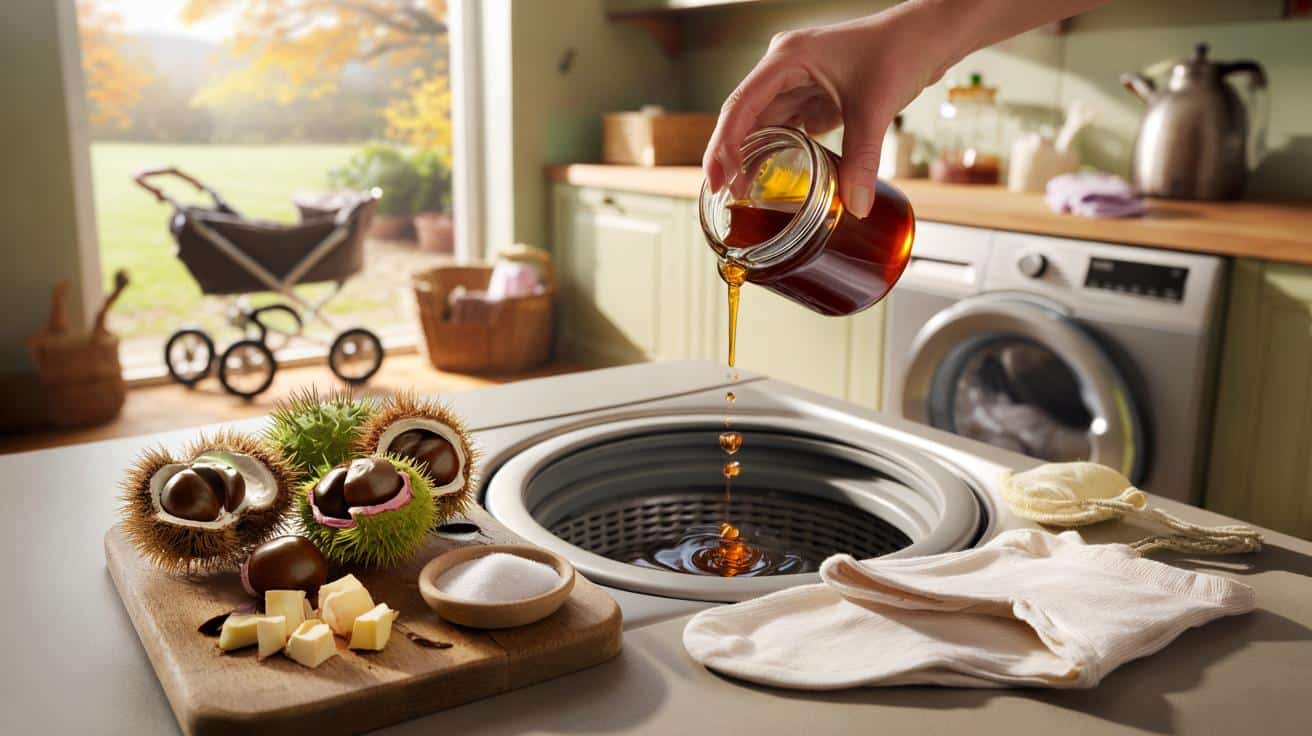Supermarket detergents are pricey, heavily perfumed, and arrive in big jugs that clutter cupboards and the planet. So when a British mum quietly shared a washing liquid recipe made from chestnuts she picked under a local tree, neighbours paid attention. The promise felt disarmingly simple: free, low-waste, and gentle on small kids’ skin.
It’s a soft October morning in a Kent park, the kind where the air smells faintly of damp leaves and dog walks. A mum with a buggy stoops to pocket shiny conkers, the ritual as familiar as school runs and lost gloves. Back home, the kettle steams, a jam jar fills with amber liquid, and she tips it into the washing machine like a secret.
The drum turns. Socks swirl. There’s no chemical fog, no neon-blue glug, just the quiet logic of a tree doing what trees do. *It smells like nothing much — and that’s the point.* The reveal, she says with a grin, is this: “It starts with a crack.”
From conker pile to clean pile
Every autumn, pavements shine with horse chestnuts, free and ignored until kids start swapping “big ones” for playground bragging rights. This mum sees something else: saponins, the plant compounds that lather when agitated. **Conkers can clean your clothes.** It’s not witchcraft, and it’s not a TikTok prank, just old knowledge dusted off for a more anxious, budget‑tight time.
Videos of chestnut “brew” have clocked up hundreds of thousands of views, which tells you the idea lands. In Britain, a household might run around 260 wash cycles a year, and small savings add up fast. One jar made from five or six conkers can cover a load, and a carrier bag of fallen horse chestnuts can see you well into spring. We’ve all had that moment when the last capful of detergent dribbles out on a Sunday night.
Here’s what’s going on. Saponins are natural surfactants: they lower water’s surface tension, helping it lift dirt from fibres. That’s the same job synthetic detergents do, minus brighteners and heavy fragrance. You won’t get the billboard‑white glow of a lab blend, and tough stains still need pre‑treating, but for day‑to‑day washing, saponins earn their keep. Think of it as gentle cleaning, not heavy artillery.
The recipe you can make on a walk
Method, the mum way. Pick 5–6 firm horse chestnuts (conkers), give them a quick rinse, and crack them open with a cut on the shell. Chop into small chunks; the more surface area, the more saponins release. Cover with about 300–400 ml of hot water in a jar, lid on, and leave for 20–30 minutes until the water turns pale tea‑coloured. **Her recipe costs pennies and leaves no plastic behind.** Strain, pour the liquid into the machine’s detergent drawer, and run a regular programme.
Want it for whites? Peel off the dark skins first, or use the milky white liquid quickly to avoid any tinting. For hard water, add a small pinch of washing soda to the drawer to boost softening. Pre‑treat mud or grease with a little soap bar or bicarbonate paste. Store any leftover liquid in the fridge for up to two days, or freeze chopped conkers in ice‑cube trays. Let’s be honest: nobody does this every day.
“I started in the cost‑of‑living crunch to save a few quid,” she says, “but I kept going because the house stopped smelling like a perfume counter.”
- Ratio: 5–6 conkers to 300–400 ml water per wash
- Contact time: 20–30 minutes in hot water, or overnight with cold
- For whites: peel the brown skins; use fresh extract
- Hard water: add a pinch of washing soda
- Storage: fridge 48 hours; freeze chopped conkers for months
- Safety: horse chestnuts are not edible; keep away from kids and pets
What this tiny ritual changes
Swap a blue bottle for a jar and you shift more than money. The smell of your laundry becomes the smell of your laundry, not a blanket of synthetic scent. You avoid lugging home plastic that lingers for centuries. You learn that plants pulse with hidden chemistry, and that a tree on your street can quietly lighten the footprint of ordinary days.
It’s not a silver bullet. Heavy stains still ask for elbow grease, and whites sometimes want a brightening booster on sunny days. But the rhythm of chopping, soaking, pouring — a handful of minutes — becomes its own calm counter to the churn of shopping lists and notifications. **You probably have everything you need within walking distance.** And if someone asks what magic you used, tell them the truth: autumn did the heavy lifting.
| Point clé | Détail | Intérêt pour le lecteur |
|---|---|---|
| Cost per wash | Free if foraged; a pinch of washing soda is pennies | Saves money across ~260 cycles a year |
| Planet perks | No plastic jugs, biodegradable surfactants, low transport | Lower waste without changing your machine |
| Everyday ease | 5–6 conkers, 20–30 minutes soak, strain and go | Simple habit that fits busy schedules |
FAQ :
- Can I use any chestnut?Use horse chestnuts (conkers), not edible sweet chestnuts for baking. Conkers are rich in saponins, the stuff that does the cleaning.
- Will it work in a cold wash?Yes, but soak longer. Use hot water to extract the liquid, then it cleans fine in a 30°C or 20°C cycle.
- Is it safe for sensitive skin and baby clothes?Many people find the fragrance‑free result kinder to skin. Always patch‑test a small item, and skip essential oils if you’re washing for a newborn.
- What about whites and delicate fabrics?Peel the brown skins before extracting for whites, and use fresh liquid. For silk or wool, test first and choose a gentle cycle.
- Does it leave a smell?Mostly none. Add a drop or two of essential oil to the drawer if you like a hint of scent, though the neutral finish is part of the charm.








